Developer Guide
Table of Contents
- Acknowledgements
- Setting up, getting started
- Design
- Implementation
- Documentation, logging, testing
- Appendix: Requirements
- Use Cases
Acknowledgements
- Libraries used: JavaFX, Jackson, JUnit5
- This project is based on the AddressBook-Level3 project created by the SE-EDU initiative.
Setting up, getting started
Refer to the guide Setting up and getting started.
Quick Set-up
- Ensure that you have Java 11 or above installed.
- Fork this repo, and clone the fork into your local computer.
Design
.puml files used to create diagrams in this document can be found in the diagrams folder. Refer to the PlantUML Tutorial at se-edu/guides to learn how to create and edit diagrams.
Architecture
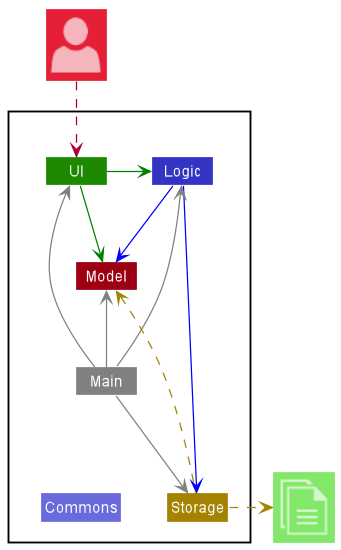
The Architecture Diagram given above explains the high-level design of the App.
Given below is a quick overview of main components and how they interact with each other.
Main components of the architecture
Main has two classes called Main and MainApp. It is responsible for,
- At app launch: Initializes the components in the correct sequence, and connects them up with each other.
- At shut down: Shuts down the components and invokes cleanup methods where necessary.
Commons represents a collection of classes used by multiple other components.
The rest of the App consists of four components.
-
UI: The UI of the App. -
Logic: The command executor. -
Model: Holds the data of the App in memory. -
Storage: Reads data from, and writes data to, the hard disk.
How the architecture components interact with each other
The Sequence Diagram below shows how the components interact with each other for the scenario where the user issues the command delete 1.
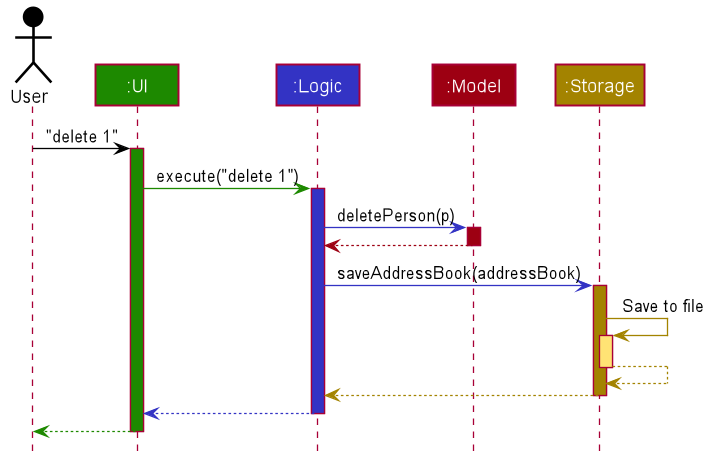
Each of the four main components (also shown in the diagram above),
- defines its API in an
interfacewith the same name as the Component. - implements its functionality using a concrete
{Component Name}Managerclass (which follows the corresponding APIinterfacementioned in the previous point.
For example, the Logic component defines its API in the Logic.java interface and implements its functionality using the LogicManager.java class which follows the Logic interface. Other components interact with a given component through its interface rather than the concrete class (reason: to prevent outside component’s being coupled to the implementation of a component), as illustrated in the (partial) class diagram below.

The sections below give more details of each component.
UI component
The API of this component is specified in Ui.java
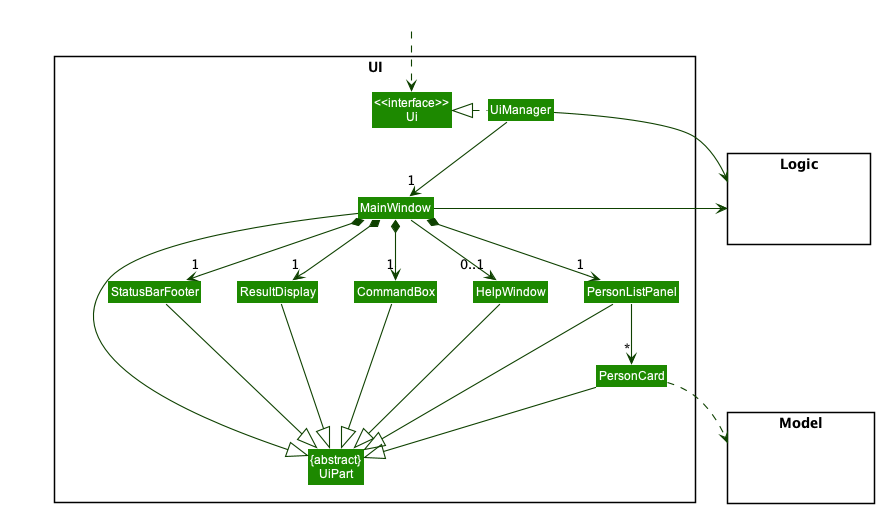
The UI consists of a MainWindow that is made up of parts e.g.CommandBox, ResultDisplay, PersonListPanel, StatusBarFooter etc. All these, including the MainWindow, inherit from the abstract UiPart class which captures the commonalities between classes that represent parts of the visible GUI.
The UI component uses the JavaFx UI framework. The layout of these UI parts are defined in matching .fxml files that are in the src/main/resources/view folder. For example, the layout of the MainWindow is specified in MainWindow.fxml
The UI component,
- executes user commands using the
Logiccomponent. - listens for changes to
Modeldata so that the UI can be updated with the modified data. - keeps a reference to the
Logiccomponent, because theUIrelies on theLogicto execute commands. - depends on some classes in the
Modelcomponent, as it displaysPersonobject residing in theModel.
Logic component
API : Logic.java
Here’s a (partial) class diagram of the Logic component:
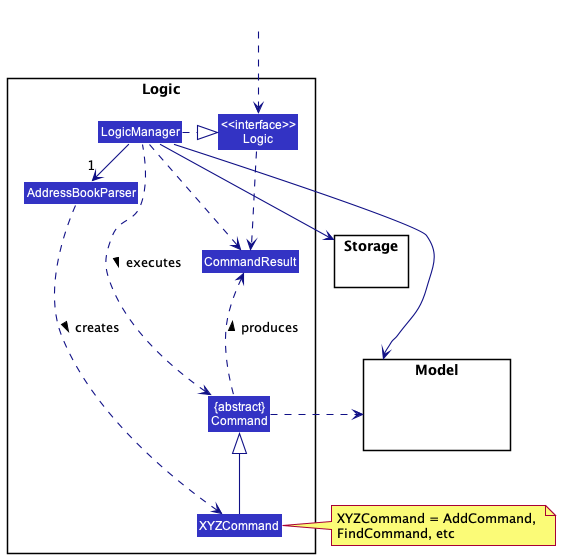
How the Logic component works:
- When
Logicis called upon to execute a command, it uses theAddressBookParserclass to parse the user command. - This results in a
Commandobject (more precisely, an object of one of its subclasses e.g.,AddCommand) which is executed by theLogicManager. - The command can communicate with the
Modelwhen it is executed (e.g. to add a person). - The result of the command execution is encapsulated as a
CommandResultobject which is returned back fromLogic.
The Sequence Diagram below illustrates the interactions within the Logic component for the execute("delete 1") API call.
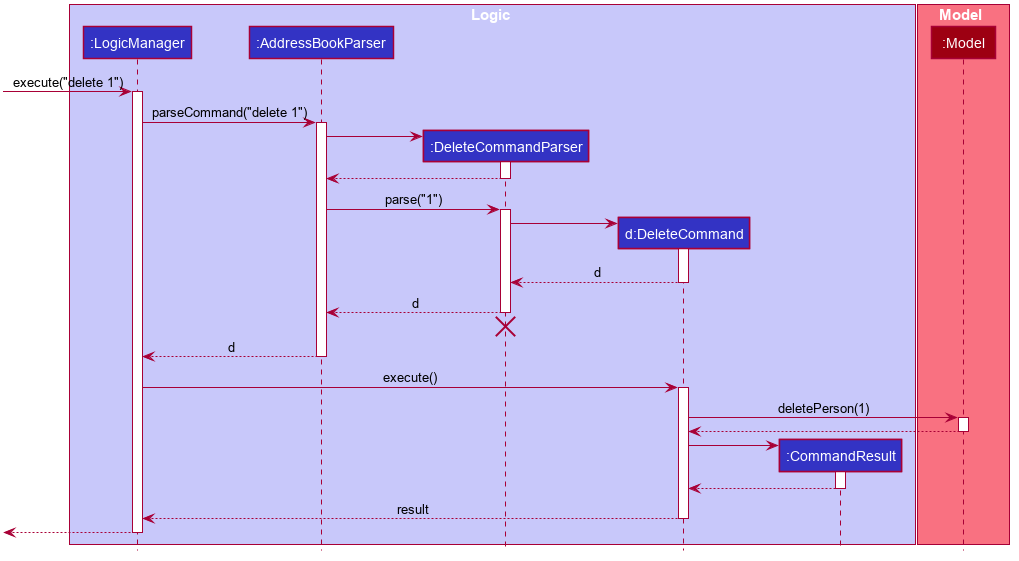
DeleteCommandParser should end at the destroy marker (X) but due to a limitation of PlantUML, the lifeline reaches the end of diagram.
Here are the other classes in Logic (omitted from the class diagram above) that are used for parsing a user command:
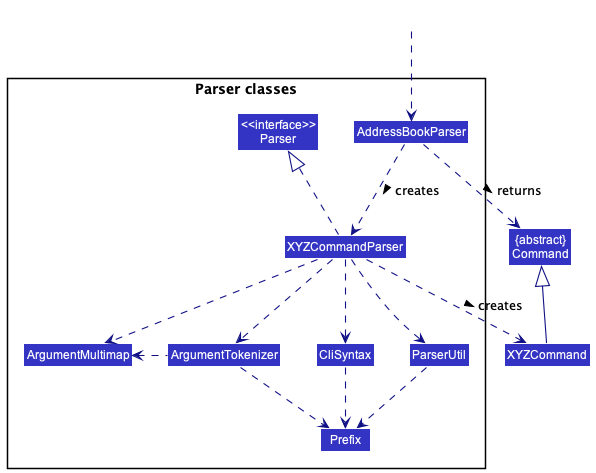
How the parsing works:
- When called upon to parse a user command, the
AddressBookParserclass creates anXYZCommandParser(XYZis a placeholder for the specific command name e.g.,AddCommandParser) which uses the other classes shown above to parse the user command and create aXYZCommandobject (e.g.,AddCommand) which theAddressBookParserreturns back as aCommandobject. - All
XYZCommandParserclasses (e.g.,AddCommandParser,DeleteCommandParser, …) inherit from theParserinterface so that they can be treated similarly where possible e.g, during testing.
Model component
API : Model.java
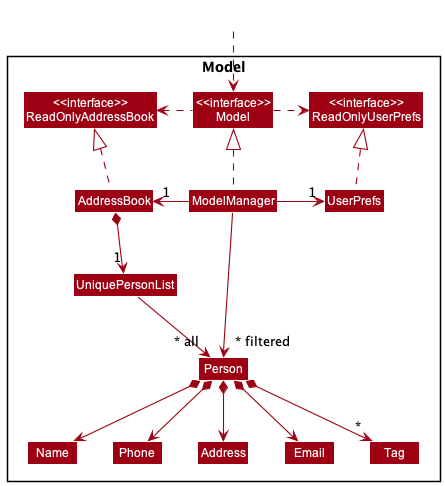
The Model component,
- stores the address book data i.e., all
Personobjects (which are contained in aUniquePersonListobject). - stores the currently ‘selected’
Personobjects (e.g., results of a search query) as a separate filtered list which is exposed to outsiders as an unmodifiableObservableList<Person>that can be ‘observed’ e.g. the UI can be bound to this list so that the UI automatically updates when the data in the list change. - stores a
UserPrefobject that represents the user’s preferences. This is exposed to the outside as aReadOnlyUserPrefobjects. - does not depend on any of the other three components (as the
Modelrepresents data entities of the domain, they should make sense on their own without depending on other components)
Tag list in the AddressBook, which Person references. This allows AddressBook to only require one Tag object per unique tag, instead of each Person needing their own Tag objects.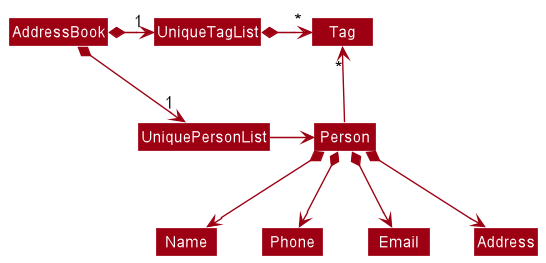
Storage component
API : Storage.java
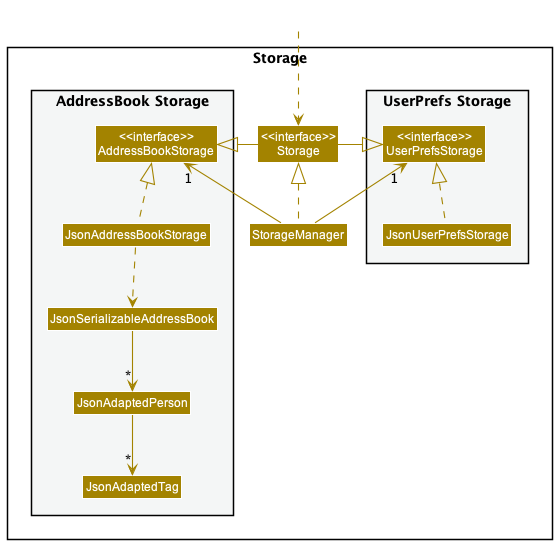
The Storage component,
- can save both address book data and user preference data in json format, and read them back into corresponding objects.
- inherits from both
AddressBookStorageandUserPrefStorage, which means it can be treated as either one (if only the functionality of only one is needed). - depends on some classes in the
Modelcomponent (because theStoragecomponent’s job is to save/retrieve objects that belong to theModel)
Common classes
Classes used by multiple components are in the seedu.addressbook.commons package.
Implementation
This section describes some noteworthy details on how certain features are implemented.
Undo feature
It extends AddressBook with an undo history, stored internally as a ReadOnlyAddressBook.
The operation is exposed in the Model interface as `Model#setAddressBook().
Given below is an example usage scenario and how the undo mechanism behaves at each step.
Step 1. The user launches the application for the first time. The originalAddressBook will be initialized with the initial address book state.
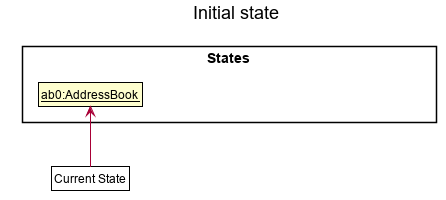
Step 2. The user executes delete 5 command to delete the 5th person in the address book. The delete command calls LogicManager#updateOriginalAddressBook(), causing the modified state of the address book after the delete 5 command executes to be saved in the ReadOnlyAddressBook, and the exCommand is updated to delete 5.
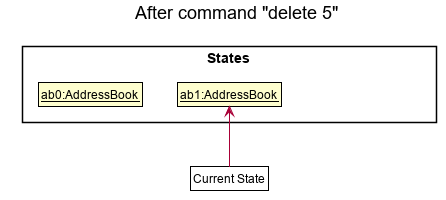
Step 3. The user decides that deleting the person was a mistake, and decides to undo that action by executing the undo command. The undo command will determine the exCommand is a delete command and call Model#setAddressBook(), which will reset the address book to the originalAddressBook.
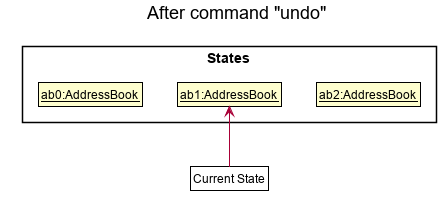
The following sequence diagram shows how the undo operation works:
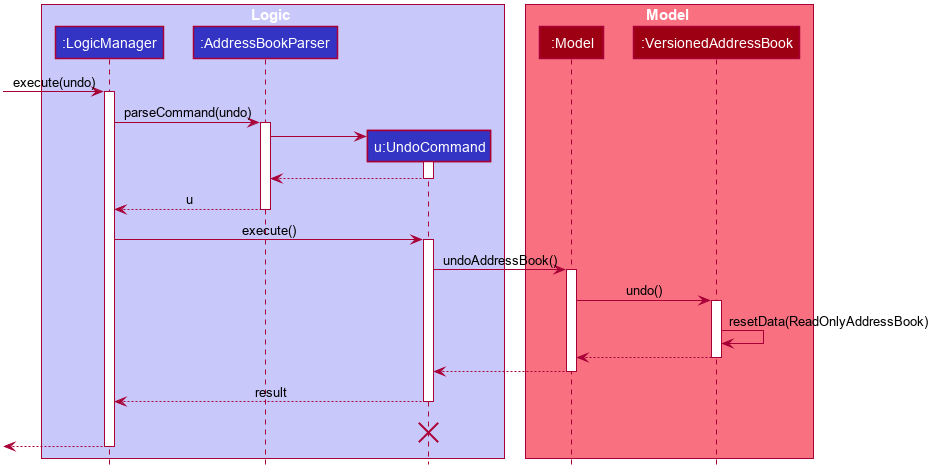
UndoCommand should end at the destroy marker (X) but due to a limitation of PlantUML, the lifeline reaches the end of diagram.
Design considerations:
BUDDY App leverages on Java Stream and jSON data structures, to allow a single user create and edit contracts to their preference:
Aspect: How undo & redo executes:
-
Alternative 1 (current choice): Saves the entire address book.
- Pros: Easy to implement.
- Cons: May have performance issues in terms of memory usage.
-
Alternative 2: Individual command knows how to undo/redo by
itself.
- Pros: Will use less memory (e.g. for
delete, just save the person being deleted). - Cons: We must ensure that the implementation of each individual command are correct.
- Pros: Will use less memory (e.g. for
Aspect: How filter executes:
-
Alternative 1 (current choice): filter down to one category tag
- Pros: Easy to manage contracts in one category tag.
- Cons: Not able to view other contact in the listing.
-
Alternative 2: filter multiple category tag
- Pros: Combine two category tag into one result view
- Cons: May have to navigate through all contacts within tag.
{more aspects and alternatives to be added}
Relate feature
Relate Command extends Command Abstract Class.
Relate Command serves 2 purposes with one command keyword relate:
- create relationship
- display people’s related contacts.
Which relies on RelateCommandParser to identify Index to and Optional<List<Index>> from, as well as RelateToPersonPredicate that filters matched Person from Model.
The sequence diagram of how RelateCommand related to various components:
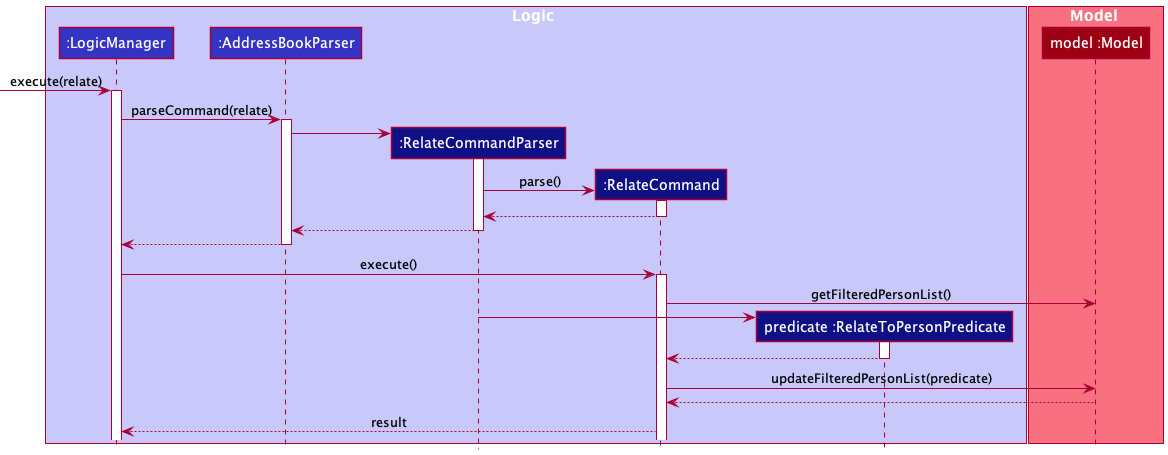
Design considerations:
The data structure to hold the mutual relationship chosen to be Set. Because in a pool of people related to a person should not have any duplicated one.
Originally, Set<Person> seem to be a natural choice which largely aligns with logic: Person has relation with another person. However, relation would be one of attributes of a person which later will be store in the json file. It could be difficult to store a list of JS Object under an Object. Unless we create another json file just for mapping relations, which could be more like a DataBase tables kind of storage.
I noticed that the id to identify a person in the original code base is actually name, which is why it does not allow person with same name. So for the ease of storage, I decidede to use Set<Name> to store the relation of person.
[Proposed] Data archiving
{Explain here how the data archiving feature will be implemented}
Documentation, logging, testing, configuration, dev-ops
Appendix: Requirements
Product scope
Target user profile
Karen, secondary school teacher with work commitments As a typical teacher managing 40 students in a class and in charge of other co-curricular activities, it is always a hassle to manage the contacts of students’ and parents’ information. In addition, manage contact information of external vendors that are involved in co-curricular activities and school’s event.
Value proposition
Project BUDDY is a Teacher’s Contact Management Application supported by CLI text input commands. Teachers can enter contact information for a swift search and retrieve desired contact information within a few keystrokes. The application provides an all-in-one display of the contacts related information and their details are presented in a beautiful scrolling view.
User stories
Priorities: High (must have) - * * *, Medium (nice to have) - * *, Low (unlikely to have) - *
| no. | As a | I want to | so that I can |
|---|---|---|---|
| 1 | forgetful user | record down people’s number and address | contact them later |
| 2 | organized user | group contacts into different labels | quickly filter out the category I want |
| 3 | productive user | search contact by name or number | find a contact easily |
| 4 | school teacher | know which student and parents belong to the same family | call the parents of the student |
| 5 | school teacher that uses multiple softwares | copy a particular contact info | paste it in other app to make use of the info |
| 6 | school teacher | know which students belong to which class | use the filtered list to take attendance |
| 7 | contacts user | take notes for a particular contact | record down happenings involving this contact |
| 8 | GUI user | have different tags in different colors | be visually pleased and easily distinguish them |
| 9 | contacts user | quickly filter out all contacts without a tag | assign at least one tag to them |
| 10 | contacts user | batch select a list of contacts for editing | assign tags to multiple contacts at once |
| 11 | careless user | undo the previous command | I will not lose my students’ contact details. |
| 12 | typo-prone user | edit the contact | correct the typo |
| 13 | visual person | add photos to the contacts | recall their identities |
| 14 | school teacher | record students’ birthdays and filter contacts by birthday months | prepare gifts in advance |
| 15 | school teacher | record contacts’ email address | contact them later |
| 16 | Diligent school teacher | Which students needs help in particular subject | Keep a close update on student’s subject progress |
| 17 | Health concerning teacher | Get quick access to student’s emergency contact | Call the contact immediately |
| 18 | Achievement motivating teacher | highlight students with high flying result | identity them to partake in school or national competitions |
| 19 | Co-curricular teacher | group my co-curricular students | Send updates on co-curricular activities |
| 20 | Concerning teacher | Highlight students who often skipped classes or missed homework | Contact student for a one to one session |
| 21 | Starter | Add some sample data within the code | get familiar with the app interface and features |
| 22 | Organized person | sort by Alphabetical order | quickly find out someone based on name |
| 23 | Visual Person | Setting preference - colors or notification | distinguish people more easily |
{More to be added}
Use cases
(For all use cases below, the System is the Project BUDDY and the Actor is the user, unless specified otherwise)
Use case: Add a person
**add n/NAME p/PHONE_NUMBER b/BIRTHDAY e/EMAIL a/ADDRESS [t/TAG]
Use case: Edit a person **edit INDEX (must be a positive integer) [n/NAME] [b/BIRTHDAY] [p/PHONE] [e/EMAIL] [a/ADDRESS] [t/TAG] …
Use case: Undo a command
MSS
- User accidentally deletes a wrong person from the contact list
- User requests to undo the delete command
-
AddressBook recovered to the original list
Use case ends.
Use case: Copy a contact
MSS
- User requests to list persons
- AddressBook shows a list of persons
- User requests to copy a specific person in the list
-
The contact details are copied
Use case ends.
Extensions
-
2a. The list is empty.
Use case ends.
-
3a. The given index is invalid.
-
3a1. AddressBook shows an error message.
Use case resumes at step 2.
-
{More to be added}
Non-Functional Requirements
- Should work on any mainstream OS as long as it has Java 11 or above installed.
- Should be able to hold up to 1000 persons without a noticeable sluggishness in performance.
- The command should be simple enough so that users are able to accomplish most of the tasks faster using typing than using the mouse.
- Should be easy for new users to get used to usage fast.
Glossary
Mainstream OS: Windows, Linux, Unix, OS-X
- Private contact detail: A contact detail that is not meant to be shared with others {More to be added}
Appendix: Instructions for manual testing
Given below are instructions to test the app manually.
Launch and shutdown
-
Initial launch
-
Download the jar file and copy into an empty folder
-
Double-click the jar file Expected: Shows the GUI with a set of sample contacts. The window size may not be optimum.
-
-
Saving window preferences
-
Resize the window to an optimum size. Move the window to a different location. Close the window.
-
Re-launch the app by double-clicking the jar file.
Expected: The most recent window size and location is retained.
-
-
{ more test cases … }
Deleting a person
-
Deleting a person while all persons are being shown
-
Prerequisites: List all persons using the
listcommand. Multiple persons in the list. -
Test case:
delete 1
Expected: First contact is deleted from the list. Details of the deleted contact shown in the status message. Timestamp in the status bar is updated. -
Test case:
delete 0
Expected: No person is deleted. Error details shown in the status message. Status bar remains the same. -
Other incorrect delete commands to try:
delete,delete x,...(where x is larger than the list size)
Expected: Similar to previous.
-
-
{ more test cases … }
Relate
- Relate a group of persons to a person
- Prerequisites: List all persons using the
listcommand. Multiple persons in the list. - Test case:
relate 2 <- 1 4 5 - Expect: contact 1 2 4 5 displayed (potentially other existing related contacts). Output message shows: contact2_Name has relation with: [“contact1_Name” “contact4_Name” “contact5_Name” “otherExistingNames”]
- Test case:
relate 2 <- 1000 - Expect: Invalid contact index message
- Test case:
relate 1000 <- 1 - Expect: Invalid contact index message
- Prerequisites: List all persons using the
- Display all related persons of a person
- Test case:
relate 2 - Expect: contact 1 2 4 5 displayed (potentially other existing related contacts). Output message shows: contact2_Name has relation with: [“contact1_Name” “contact4_Name” “contact5_Name” “otherExistingNames”]
- Test case:
relate 1000 - Expect: Invalid contact index message
- Test case:
Saving data
-
Dealing with missing/corrupted data files
- {explain how to simulate a missing/corrupted file, and the expected behavior}
-
{ more test cases … }